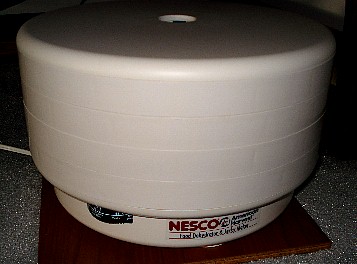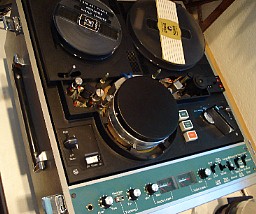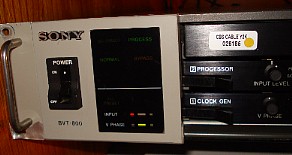
The 1972 DCI Championships
- video restoration -
The Jim Jones (Troopers) Historic Video Library consists of approximately
sixty early-1970s EIAJ 1/2-inch Sony video open-reel videotapes. The tapes
were never intended to be archived, but rather were used instead for
instructional purposes. As a result, they were frequently reused and many of
the shows were lost - overwritten by other shows or rehearsals. However, many
remarkable recordings remain, some of which are astonishing in their
historic significance.

 One such tape, of great interest, is shown at the left (the label has
been blotted out for dramatic effect).
Although they can appear to be in perfect condition, in fact most have
deteriorated in various ways. For example, they all exhibit a common
problem known as sticky shed, where the binding has collected
moisture over the years and causes a sticky residue to emerge when played.
On these tapes, it is so severe that playback halts after about 10 seconds.
Before they can be successfully played, they need to be baked.
This is accomplished by using a food dehydrator
(shown at right) set at 130 degrees for about 4 hours.
One such tape, of great interest, is shown at the left (the label has
been blotted out for dramatic effect).
Although they can appear to be in perfect condition, in fact most have
deteriorated in various ways. For example, they all exhibit a common
problem known as sticky shed, where the binding has collected
moisture over the years and causes a sticky residue to emerge when played.
On these tapes, it is so severe that playback halts after about 10 seconds.
Before they can be successfully played, they need to be baked.
This is accomplished by using a food dehydrator
(shown at right) set at 130 degrees for about 4 hours.
After baking, the tapes can be played. I am fortunate to have one of the
very best EIAJ decks (Panasonic NV-3160) and a couple of suitable time-base
correctors (an AV-Tool-8710 and a Sony BVT-800) which are essential for
stabilizing video images this old.



The video and audio are thus (1) transfered to computer, (2) stored
in digital files, and (3) backups are made.
EIAJ video typically has poor long-term storage characteristics. Therefore,
after capture, most of the videos display any of several problems which need
to be corrected using computer software. The primary tool I use for this is
called Virtualdub. A huge library
of Virtualdub video filters are available which are designed for correcting
various problems in degraded video. After
months of trial-and-error, I have found the following filters to be
useful in cleaning and stabilizing these video captures (listed with
their authors):
- Median Filter (Sergey Stolyarevskiy)
- Area-Based Deinterlace (Gunnar Thalin)
- MSU Smart Brightness (Moscow State University Video Group)
- Linear Hindrances (Sergey Stolyarevskiy)
- DeShaker (Gunnar Thalin)
Note the repair of horizontal
static lines, stabilization of video, and improved contrast:

Video shakiness is also repaired (using DeShaker), but that of course
cannot be appreciated in a still photograph. Maybe I'll post an example
of that if I get time... the difference in quality is dramatic.
The AUDIO on these old tapes also needs considerable attention.
All of the 1972 tapes had a nasty whine, both at 8000 Hz and at 16,000 Hz,
making them very hard on the ears. Standard audio editing software was
used, but the removal of the whine and general mastering was done using
the paragraphic equalizer in a product
called Ozone:

Although the audio could easily have been replaced with the excellent
stereo DCI recordings from the same show, we believe that the audio on
these videos is of high enough quality to deserve preservation.
Hopefully, you will agree that these recordings have their own unique
qualities and provide enjoyable listening.
The entire process of baking, capturing, repairing video and audio,
stabilizing, and encoding takes several days per corps, once a set of
appropriate filters has been identified. The two disks in this set
reflect several months of effort.
Some problems persist in the videos and cannot be repaired.
You may notice the following:
- fast cutoffs - usually only a second or two after the end of a performance.
- rough starts - the recording deck most likely powered-up slowly.
- dropouts - 27th Lancers, for example, have a 3-second audio "hole".
- crinkled tape - causing periodic bunches of horizontal bands.
- Bridgemen - very rough start which affects the first 30 sec.
of audio.
- missing tapes - Cavaliers, Muchachos, Des Plaines Vanguard,
and ironically the Troopers.
I hope that you enjoy these historic treasures in spite of
their blemishes. Actually, finding these kinds of tapes in such
remarkably good condition is rare - we are fortunate that the Troopers
took good care of this precious library!
-Scott
hardbat homepage
contact: sgordon@hardbat.com

 One such tape, of great interest, is shown at the left (the label has
been blotted out for dramatic effect).
Although they can appear to be in perfect condition, in fact most have
deteriorated in various ways. For example, they all exhibit a common
problem known as sticky shed, where the binding has collected
moisture over the years and causes a sticky residue to emerge when played.
On these tapes, it is so severe that playback halts after about 10 seconds.
Before they can be successfully played, they need to be baked.
This is accomplished by using a food dehydrator
(shown at right) set at 130 degrees for about 4 hours.
One such tape, of great interest, is shown at the left (the label has
been blotted out for dramatic effect).
Although they can appear to be in perfect condition, in fact most have
deteriorated in various ways. For example, they all exhibit a common
problem known as sticky shed, where the binding has collected
moisture over the years and causes a sticky residue to emerge when played.
On these tapes, it is so severe that playback halts after about 10 seconds.
Before they can be successfully played, they need to be baked.
This is accomplished by using a food dehydrator
(shown at right) set at 130 degrees for about 4 hours.





